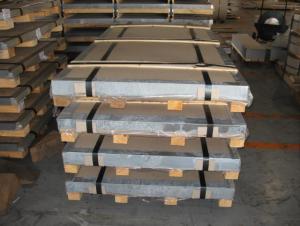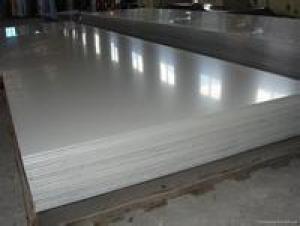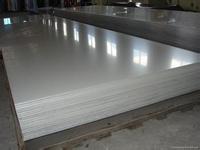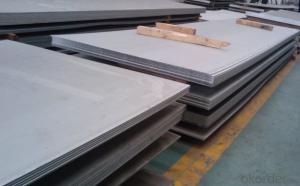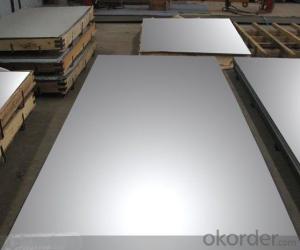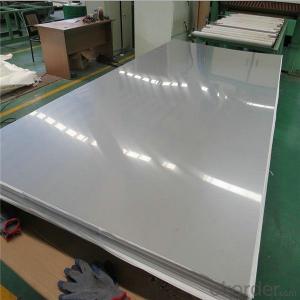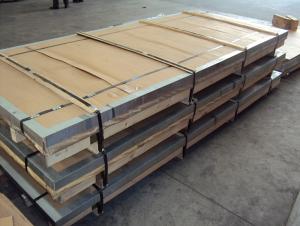Stainless Steel Sheet 8K Surface Treatment 0.8mmx1220mmx2440mm
- Loading Port:
- Shanghai
- Payment Terms:
- TT OR LC
- Min Order Qty:
- 25 m.t.
- Supply Capability:
- 2500 m.t./month
OKorder Service Pledge
OKorder Financial Service
You Might Also Like
Product Introduction of Stainless Steel Sheet 8K Surface Treatment 0.8mmx1220mmx2440mm:
Our Stainless Steel products including the stainless steel sheet/plate, stainless steel coil, stainless steel rod/bar, stainless steel angle, stainless steel strip, stainless steel flat, carbon steel products and alloy steel materials. It also can supply the processing of surface, like No.4, BA, HL, SB, 8K, and so on.
Loading Quantity of Stainless Steel Sheet 8K Surface Treatment 0.8mmx1220mmx2440mm:
25 Tons/20FCL.
Grade Stainless of Steel Sheet 8K Surface Treatment 0.8mmx1220mmx2440mm: 201, 306, 316 Etc.
Delivery Time of Stainless Steel Sheet 8K Surface Treatment 0.8mmx1220mmx2440mm:
20 days Per Container.
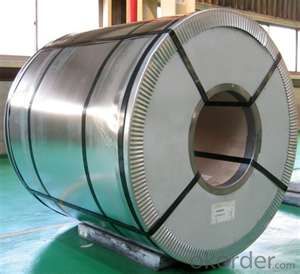
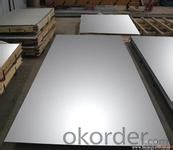
Application of Stainless Steel Sheet 8K Surface Treatment 0.8mmx1220mmx2440mm:
| Finish | Thickness | Characteristics | Applications |
| No. 1 | 3.0mm~50.0mm | Finished by hot-rolling, annealing and pickling, characterized by white pickled surface | Chemical industry equipment, Industrial tanks |
| No. 2B | 0.3mm~6.0mm | Finished by heat treatment, pickling after cold rolling, followed by skin pass line to be more brighter and smooth surface | General Application Medical Instruments,Tableware |
| No. BA (Bright Annealed) | 0.5mm~2.0mm | Bright heat treatment after cold rolling | Kitchen utensil, kitchen ware,architectural purpose |
| No. 4 | 0.4mm~3.0mm | Polishing with No. 150 to No.180 mesh abrasivesThe most popular finishes | Milk & Food processing acilities, Hospital Equipment, Bath-tub |
| HL(Hair Line) | 0.4mm~3.0mm | Finished by continuous linear polishing | Architectural purposes, escalators, kitchen ware vehicles |
Specification of Stainless Steel Sheet 8K Surface Treatment 0.8mmx1220mmx2440mm:
Type | Wuxi boro-304/304L/316/316L/321/309S/310S/904L/202/201/430 stainless steel sheet |
Thinckness | 0.3mm-60mm |
Widthness | 50mm~2000mm or customized |
Length | 1000mm~8000mm or customized |
Brand name | CNBM |
Standard | JIS, AISI, ASTM, GB, DIN, EN |
Material | 201/201/304/304L/316/316L/321/309S/310S/904L stainless steel sheet |
Surface | 2B,BA,HL,BK,NO.1,NO.4,8K,SB,etc |
Certificate | We accept the third inspections--SGS-BV etc. |
Application | Bridge, Shipbuilding,roofing,Car, etc |
Standard sheet sizes | 1000mm*2000mm,1250mm*2500mm,1219mm*2438mm,1500mm*3000mm We can produce other standard as customized |
FAQ
Q: CAN YOU PROVIDE MILL TEST CERTIFICATE?
A: YES! Mill Test Certificate for Stainless Steel Sheet 8K Surface Treatment 0.8mmx1220mmx2440mm are available.
Q: CAN YOU MAKE DDQ (DEEP DRAWING QUALITY)?
A: YES. Our material has been widely used for producing Stainless Steel Pots and Stainless Steel Sinks, which have strict request for good deep drawing quality.
Q: HOW TO GET A SAMPLE?
A: FREE samples for Stainless Steel Sheet 8K Surface Treatment 0.8mmx1220mmx2440mm are available for your checking and testing. And to get free samples, you need to send us you detailed receiving address (including post code) and your DHL/FedEx/UPS account for collecting samples, courier cost will be paid in your side.
- Q: Can stainless steel sheets be used in food processing or medical applications?
- Yes, stainless steel sheets can be used in food processing and medical applications. Stainless steel is highly resistant to corrosion and is easy to clean, making it suitable for use in environments that require strict hygiene standards such as food processing plants and medical facilities. It is also non-reactive with food and medical substances, ensuring the safety and quality of the products being processed or treated.
- Q: How do I select the appropriate thickness for stainless steel sheets?
- To select the appropriate thickness for stainless steel sheets, you need to consider factors such as the application, desired durability, strength requirements, and cost. Thicker sheets are generally more durable and offer higher strength, but they may also be more expensive. It is advisable to consult with a stainless steel supplier or industry expert who can assess your specific needs and provide guidance on the most suitable thickness for your project.
- Q: Can stainless steel sheets be used in industrial applications?
- Stainless steel sheets possess a myriad of industrial uses without a doubt. Their reputation for outstanding corrosion resistance, durability, and strength renders them perfect for a plethora of industrial settings. The automotive, aerospace, construction, manufacturing, food and beverage, chemical processing, and numerous other sectors regularly employ this material. The utilization of stainless steel sheets primarily stems from their capability to withstand extreme conditions, harsh chemicals, and high temperatures. Their malleability allows for the creation of diverse shapes and sizes, rendering them adaptable for a wide array of applications. Commonly, stainless steel sheets find their purpose in manufacturing equipment, machinery, storage tanks, pipelines, architectural structures, and as a protective layer for corrosion-resistant surfaces. Additionally, stainless steel sheets offer sanitary qualities, which make them particularly suitable for the food and beverage industry. Their effortless cleaning, maintenance, and sterilization ensure compliance with rigorous industry standards. To summarize, stainless steel sheets are versatile and dependable materials that can be effectively utilized in various industrial applications due to their extraordinary corrosion resistance, durability, strength, and sanitary properties.
- Q: What is the width range available for stainless steel sheets?
- The width range available for stainless steel sheets can vary depending on the supplier, but it typically ranges from 36 inches to 72 inches.
- Q: What's the drill for stainless steel?
- And the feed amount is greater than 0.15mm, so as not to cut the cold work hardening layer as much as possible. The cutting speed is as low as possible to reduce the cutting temperature.
- Q: What are the different surface textures available for stainless steel sheets?
- There are several different surface textures available for stainless steel sheets, including brushed, mirror, satin, embossed, and patterned.
- Q: Are stainless steel sheets suitable for roofing?
- Yes, stainless steel sheets are suitable for roofing. They have excellent durability, corrosion resistance, and can withstand extreme weather conditions. Additionally, their sleek appearance adds aesthetic value to any building.
- Q: What are the different types of stainless steel sheet surface patterns?
- In various industries, different types of surface patterns are commonly used for stainless steel sheets. Here are some of the most prevalent patterns: 1. The most commonly used pattern for stainless steel sheets is the No. 1 Finish. This pattern is achieved by hot rolling the sheet, resulting in a dull, rough, and non-reflective finish. 2. The No. 2B Finish has a smooth and moderately reflective surface. It is obtained through cold rolling the stainless steel sheet and then annealing it in a controlled atmosphere to eliminate any scale or oxide buildup. 3. Similar to the No. 2B finish, the No. 3 Finish has a slightly coarser and less reflective surface. It is often used for decorative purposes, particularly in architectural applications. 4. The No. 4 Finish is a popular choice for stainless steel sheet surfaces. It showcases a brushed appearance with fine parallel lines running in one direction. This brushed finish is achieved by using abrasive belts or brushes to create a consistent pattern on the surface. 5. The No. 8 Mirror Finish provides a highly reflective, mirror-like surface, as the name suggests. It is achieved by polishing the stainless steel sheet to a high shine using progressively finer abrasive materials. 6. The Embossed Finish displays a raised, textured pattern on the surface of the stainless steel sheet. It can be achieved through various methods, such as embossing rollers or heat transfer. 7. The Bead Blasted Finish offers a uniform, matte appearance with a slightly rough texture. It is created by bombarding the stainless steel sheet with fine glass beads at high pressure, resulting in a consistent and non-reflective surface. Each of these stainless steel sheet surface patterns possesses distinct aesthetic and functional qualities. The choice of pattern depends on the specific application and desired outcome, whether it is for architectural, industrial, or decorative purposes.
- Q: What are the common methods of cutting stainless steel sheets?
- The common methods of cutting stainless steel sheets include shearing, laser cutting, plasma cutting, and waterjet cutting.
- Q: What are the common manufacturing standards for stainless steel sheets?
- There are several common manufacturing standards for stainless steel sheets that ensure their quality and consistency. One of the most widely recognized standards is the ASTM International (formerly known as the American Society for Testing and Materials) standard. ASTM A240 is the specific standard for stainless steel sheets, which specifies the requirements for chemical composition, mechanical properties, and other relevant characteristics of the material. Another important manufacturing standard is the EN (European Norm) standard, specifically EN 10088, which provides guidelines for stainless steel flat products, including sheets. This standard covers various aspects such as dimensions, tolerances, surface finishes, and more. Additionally, there are national standards developed by different countries. For example, in Japan, the Japanese Industrial Standards (JIS) classify stainless steel sheets under various specifications such as JIS G4304 and JIS G4305. These standards define the requirements for chemical composition, mechanical properties, and surface finishes of stainless steel sheets. In the United States, the American Iron and Steel Institute (AISI) also sets standards for stainless steel sheets. The AISI 300 and 400 series are commonly used in the manufacturing of stainless steel sheets, and their properties are defined by the AISI. It is important for manufacturers and suppliers to adhere to these standards to ensure that the stainless steel sheets meet the desired quality requirements and can be used reliably in various applications. These standards help maintain consistency, compatibility, and traceability in the production and use of stainless steel sheets across different industries.
Send your message to us
Stainless Steel Sheet 8K Surface Treatment 0.8mmx1220mmx2440mm
- Loading Port:
- Shanghai
- Payment Terms:
- TT OR LC
- Min Order Qty:
- 25 m.t.
- Supply Capability:
- 2500 m.t./month
OKorder Service Pledge
OKorder Financial Service
Similar products
Hot products
Hot Searches
Related keywords
